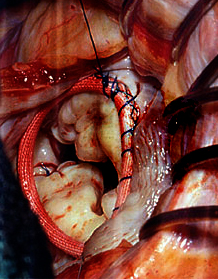- What is Mitral Stenosis (MS)
- Statistics on Mitral Stenosis (MS)
- Risk Factors for Mitral Stenosis (MS)
- Progression of Mitral Stenosis (MS)
- Symptoms of Mitral Stenosis (MS)
- Clinical Examination of Mitral Stenosis (MS)
- How is Mitral Stenosis (MS) Diagnosed?
- Prognosis of Mitral Stenosis (MS)
- How is Mitral Stenosis (MS) Treated?
- Mitral Stenosis (MS) References
What is Mitral Stenosis (MS)
Mitral stenosis is a narrowing or obstruction of the opening of the mitral valve, which separates the upper (left arium) and lower chamber (left ventricle) on the left side of the heart. This prevents adequate blood flow between the left atrium (upper chamber) and ventricle (lower chamber).
Statistics on Mitral Stenosis (MS)
Mitral valve disease is rare, but occurs in over 90% of patients who have rheumatic valvular disease – which in turn results in a proportion of people who have had rheumatic fever in childhood. Mitral valve disease due to rheumatic fever is much more common in women than in men. Symptoms often do not become apparent until many decades after the initial episode of rheumatic fever.
Risk Factors for Mitral Stenosis (MS)
The main predisposing factor is rheumatic fever– a childhood illness which is thought to be an autoimmune reaction to a streptococcal infection.
Over the past 80 years the incidence of rheumatic fever has decreased from 10% to 0.01%, probably due to improved antibiotic control of streptococcal infections. It is still a significant disease in the Middle and Far East, Eastern Europe, South America and among indigenous Aboriginal populations of Australia. Some recent epidemiological evidence suggests a possible resurgence of the disease.
Rarely, congenital mitral stenosis can occur. In addition, occasionally a similar clinical syndrome can result in the elderly due to fibrosis of the valve.
Progression of Mitral Stenosis (MS)
Rheumatic Fever as a child is followed by many decades of silent changes to the valve. When the valve orifice area is reduced to 2cm2 symptoms usually start to develop. To maintain the cardiac output, the left atrium becomes hypertrophied and a little dilated. This causes pulmonary (lung) pressures to increase which causes pulmonary oedema (fluid on the lung) and predisposes to infections (bronchitis) and eventually right heart failure ensues with peripheral oedema – swelling of the ankles and abdomen. Atrial fibrillation and valve infection (infective endocarditis) can also complicate it.
How is Mitral Stenosis (MS) Diagnosed?
Clinical suspicion should dictate:
- ECG for rhythm disturbances also rarely p-mitrale of atrial hypertrophy.
- Blood cultures is suspect infective endocarditis.
- Chest x-ray for diagnosing pulmonary oedema.
Prognosis of Mitral Stenosis (MS)
Mitral stenosis usually follows a slowly progressive course with bronchial infections, worsening dyspnoea and the signs and symptoms of atrial fibrillation. Without treatment, the end result of mitral stenosis is cardiac failure which has a very poor prognosis. However, mitral stenosis can be treated by surgical means, including valve replacement when it seems to be progressing.
How is Mitral Stenosis (MS) Treated?

Antibiotic prophylaxis may be indicated in patients with MS to prevent infective endocarditis.
If there is evidence of pulmonary hypertension, surgical correction of the problem may be indicated. Options include valvotomies (in which the cusps of the valve are forced apart either by a balloon or other dilators) and mitral valve replacement using a synthetic valve. Anticoagulation and prophylactic antibiotics may be indicated as prosthetic valves are more susceptible to clot formation and infection.
To the right is an image of open heart surgery on the mitral valve
Mitral Stenosis (MS) References
[1] Hurst’s The Heart 8th Edition, McGRAW-HILL 1994.
[2] Kumar and Clark Clinical Medicine 4th Edition, W.B SAUNDERS 1998.
[3] MEDLINEplus 2003.
All content and media on the HealthEngine Blog is created and published online for informational purposes only. It is not intended to be a substitute for professional medical advice and should not be relied on as health or personal advice. Always seek the guidance of your doctor or other qualified health professional with any questions you may have regarding your health or a medical condition. Never disregard the advice of a medical professional, or delay in seeking it because of something you have read on this Website. If you think you may have a medical emergency, call your doctor, go to the nearest hospital emergency department, or call the emergency services immediately.







